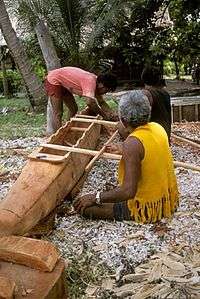Ama (sailing)
The term ama is a word in the Polynesian and Micronesian languages to describe the outrigger part of a canoe to provide stability. Today, among the various Polynesian countries, the word ama is often used together with the word vaka (Cook Islands) or waka (Māori) or va'a (Samoa Islands, Tahiti), cognate words in various Polynesian languages to describe a canoe.
In modern sailing, the term is sometimes used to refer to the outrigger on a proa or trimaran, or the two sections of a catamaran.[1] However, calling the two sections of a catamaran by the word ama, is not technically correct since they are of equal size. A catamaran is technically a wa'a wa'a or double canoe connected by an aka.[2]
History

The Polynesian term vaka is the main hull, the ama is the outrigger, and the aka or iako (Hawaiian) is the support connecting the two (not three) hulls. The term ama and aka have been widely applied to modern trimarans.
Function
On a proa, the ama may provide lift or ballast, depending on whether it is designed to be used to leeward or windward; on a trimaran it is designed primarily to provide lift. There are many shapes of ama; those used in proas are generally laterally symmetric, as the proa is designed to sail with either end forwards, while trimaran ama are one-directional and may have no axis of symmetry.
The most advanced ama are composed of highly curved surfaces which generate lift when driven forward through the water, much like an airplane wing. This lift may be directed to the windward, used to counter slipping to leeward, or may be oriented vertically to counter heeling forces from the sailing rig. These highly curved structures are much more difficult to manufacture than traditional ama, and are therefore more expensive. The Bruce foil is an example of a type of leeboard often attached to an ama to assist in producing lift.
Use of the term in other cultures
The term waka, like the related terms aka and ama, are also used in Malay and Micronesian language group. A proa consists of a waka or wa'a, the main canoe-like hull; an ama, the outrigger; and aka, the poles connecting the ama to the vaka.[1] The trimaran uses the same terminology, with a center vaka and ama and aka on each side.[3]
References
- 1 2 "A primer on proas". Archived from the original on 2007-10-08. Retrieved 2007-10-30.
- ↑ Rāwiri Taonui , Te Ara (4-Mar-09). "Story: Canoe navigation - Waka – canoes'". The Encyclopedia of New Zealand. Check date values in:
|date=(help) - ↑ "The Tridarka Raider". Archived from the original on 20 October 2007. Retrieved 2007-10-30.